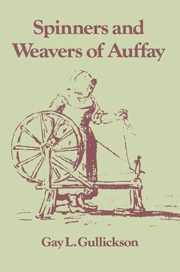 The Spinners and Weavers of Auffay
The Spinners and Weavers of Auffay Book contents
- Frontmatter
- Contents
- Preface
- 1 Introduction
- 2 The pays and the village
- 3 Proto-industrial theory and the pays de Caux
- 4 The golden age of spinning
- 5 Crisis and change in the Caux
- 6 The golden age of cottage weaving
- 7 Marriage and family in proto-industrial Auffay
- 8 Widowhood, remarriage, and the sexual division of labor
- 9 Unwed mothers and their children
- 10 Conclusions: the causes and consequences of proto-industrialization
- Appendix Vital statistics for Auffay
- Notes
- Bibliography
- Index
2 - The pays and the village
Published online by Cambridge University Press: 29 October 2009
- Frontmatter
- Contents
- Preface
- 1 Introduction
- 2 The pays and the village
- 3 Proto-industrial theory and the pays de Caux
- 4 The golden age of spinning
- 5 Crisis and change in the Caux
- 6 The golden age of cottage weaving
- 7 Marriage and family in proto-industrial Auffay
- 8 Widowhood, remarriage, and the sexual division of labor
- 9 Unwed mothers and their children
- 10 Conclusions: the causes and consequences of proto-industrialization
- Appendix Vital statistics for Auffay
- Notes
- Bibliography
- Index
Summary
The pays de Caux
The Seine River, winding slowly toward the English Channel from Paris, passes through the old province of Normandy, dividing it into two distinct sections. The smaller section lying to the north of the river was called both Haute-Normandie and Normandie Orientale, the combination describing its location in the upper, eastern portion of the province. The larger and lower part of the province, known as Basse-Normandie, lay to the south of the Seine and stretched much farther west, ending in the Cotentin Peninsula. When France was reorganized into departments during the Revolution, Upper Normandy became the Département de la Seine-Inférieure, a name that was later changed to the Département de la Seine-Maritime.
Rouen, the capital of the province and later of the Seine-Inférieure/Seine-Maritime, lay halfway between the eastern boundary of the province and the English Channel, on the northern bank of a large loop in the Seine. Connected to both the domestic markets of Paris and the export markets of England, Spain, and Portugal by short water routes, Rouen was an important commercial center well before the beginning of the eighteenth century. It was the fourth largest provincial city in France with a population that rose slowly from about 55,000 in 1700 to 100,000 in 1850.
- Type
- Chapter
- Information
- The Spinners and Weavers of AuffayRural Industry and the Sexual Division of Labor in a French Village, pp. 7 - 37Publisher: Cambridge University PressPrint publication year: 1986


